
Dacrydium cupressinum, commonly known as rimu, is a large evergreen coniferous tree endemic to the forests of New Zealand. It is a member of the southern conifer group, the podocarps.

Leptospermum scoparium, commonly called mānuka, mānuka myrtle, New Zealand teatree, broom tea-tree, or just tea tree, is a species of flowering plant in the myrtle family Myrtaceae, native to New Zealand and south-east Australia. Its nectar produces Mānuka honey.

Cordyline australis, commonly known as the cabbage tree, or by its Māori name of tī or tī kōuka, is a widely branched monocot tree endemic to New Zealand.
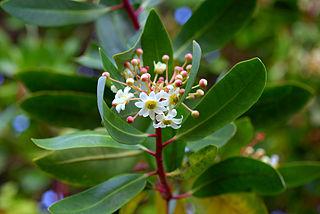
Winteraceae is a primitive family of tropical trees and shrubs including 93 species in five genera. It is of particular interest because it is such a primitive angiosperm family, distantly related to Magnoliaceae, though it has a much more southern distribution. Plants in this family grow mostly in the southern hemisphere, and have been found in tropical to temperate climate regions of Malesia, Oceania, eastern Australia, New Zealand, Madagascar and the Neotropics, with most of the genera concentrated in Australasia and Malesia. The five genera, Takhtajania, Tasmannia, Drimys, Pseudowintera, and Zygogynum s.l. all have distinct geographic extant populations. Takhtajania includes a single species, T. perrieri, endemic only to Madagascar, Tasmannia has the largest distribution of genera in Winteraceae with species across the Philippines, Borneo, New Guinea, Eastern Australia, and Tasmannia, Drimys is found in the Neotropical realm, from southern Mexico to the subarctic forests of southern South America, Pseudowintera is found only in New Zealand, and Zygogynum has species in New Guinea and New Caledonia.

Pseudowintera is a genus of woody evergreen flowering trees and shrubs, part of family Winteraceae. The species of Pseudowintera are native to New Zealand. Winteraceae are magnoliids, associated with the humid Antarctic flora of the southern hemisphere. Horopito can be chewed for a hot, peppery taste.

Aristotelia serrata, commonly known as wineberry or in the Māori language makomako or just mako, is a small tree in the family Elaeocarpaceae, in the genus Aristotelia, found in the North Island, South Island and Stewart Island of New Zealand. It is a small deciduous fast-growing tree or shrub. The tree can reach up to 10m tall, with a trunk diameter up to 30 cm. The bark is pale brown, smooth and patterned with flat lenticels. Branches are long, slender and spreading, branchlets have a reddish-brown colour when pubescent.

Urtica ferox, commonly known as tree nettle and, in Māori, ongaonga, taraonga, taraongaonga, оr okaoka, is a species of nettle endemic to New Zealand. Unlike the other species in the genus Urtica found in New Zealand, all of which are herbaceous, ongaonga is a large woody shrub that can grow to a height of 3 m (9.8 ft), with the base of the stem reaching 12 cm (4.7 in) in thickness. It has large spines that can result in a painful sting that lasts several days.

Tasmannia lanceolata, commonly known as pepper tree, native pepper, mountain pepper or mountain pepperbush, is a species of flowering plant in the family Winteraceae, and is endemic to south-eastern Australia. It is a dioecious bushy shrub to small tree with lance-shaped or narrowly ellipic leaves, male and female flowers on separate plants, the flowers with 3 to 9 petals, and the fruit a deep maroon to glossy black berry.

Syzygium anisatum, with common names ringwood and aniseed tree, is a rare Australian rainforest tree with an aromatic leaf that has an essential oil profile comparable to true aniseed.

Drimys winteri, also known as Winter's bark, foye and canelo, is a slender species of tree in the family Winteraceae, growing up to 20 m (66 ft) tall. It is native to the Magellanic and Valdivian temperate forests of Chile and Argentina, where it is a dominant tree in the coastal evergreen forests. It is found below 1,200 m (3,900 ft) between latitude 32° south and Cape Horn at latitude 56°. In its southernmost natural range it can tolerate temperatures down to −20 °C (−4 °F). The plant is renowned for its phenotypic plasticity being able to grow in different sites from "extreme arid zones to wetlands along Chile". The tree does also grow in places with various types and degrees of competition from other plants.

Pterophylla racemosa, known as the kāmahi, is an evergreen tree native to New Zealand. It is part of the Pterophylla genus which mostly includes sub-tropical species, but the kāmahi is found in a variety of New Zealand climates from coastal areas to high-elevation inland areas.

Litsea calicaris, the mangeao, is an evergreen tree endemic to the North Island of New Zealand, occurring in lowland forest from near North Cape south to about 38°S. It belongs to the Laurel family, Lauraceae.

Rumohra adiantiformis, the leather fern or leatherleaf fern, is a species of fern in the wood fern family Dryopteridaceae. It has a wide distribution, mainly in the tropical Southern Hemisphere.

Coprosma propinqua is a New Zealand plant of the genus Coprosma in the family Rubiaceae. It is a widely-distributed small leaved divaricating shrub found throughout New Zealand.
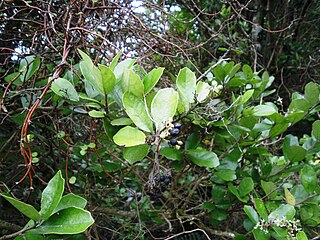
Pennantia corymbosa, commonly known as kaikomako, is a small dioecious forest tree of New Zealand.
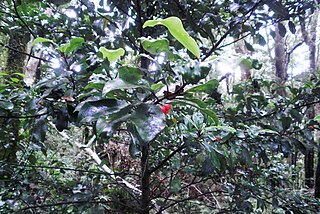
The Pseudowintera axillaris is a shrub like tree, endemic to New Zealand. They are members of the Winterace family and are known for their peppery taste, and glossy green leaves.
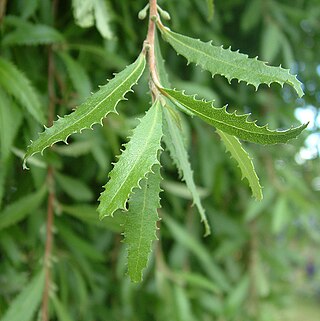
Hoheria angustifolia, the narrow-leaved lacebark or narrow-leaved houhere, is a species of flowering plant in the family Malvaceae, endemic to New Zealand. It is an evergreen tree or shrub with a weeping habit and grows to 10 m (33 ft) tall. Known as Houhere or Houhi in Māori, the bark of the tree was occasionally used for traditional textiles, similar to the traditional use of Hoheria populnea.
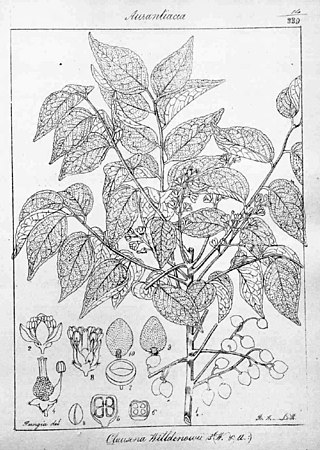
Clausena anisata (Willd.) Hook.f. ex Benth. is a deciduous shrub or small tree, belonging to the Rutaceae or Citrus family, and widespread in the Afrotropical realm or Sub-Saharan Africa, but absent from the drier regions. It is also found in tropical and South-East Asia, growing in India and Sri Lanka and extending as far as Queensland in north-eastern Australia and some Pacific islands. It is cultivated in Malaysia and Indonesia. As with other plants useful to mankind its large range of medicinal properties has led to a global distribution and its growth wherever the climate is suitable. It grows in higher-rainfall regions in savanna, thickets, riverine forest, disturbed areas and secondary forest, up to an altitude of 3000 m. The leaves, which are foetid when bruised, give rise to the common name 'Horsewood' or the more descriptive Afrikaans common name 'Perdepis', meaning 'horse urine'.

Pseudowintera traversii, sometimes called Travers horopito, is a species of woody shrub in the family Winteraceae. The specific epithet traversii is in honor of naturalist Henry H. Travers (1844–1928), son of William Thomas Locke Travers.


















